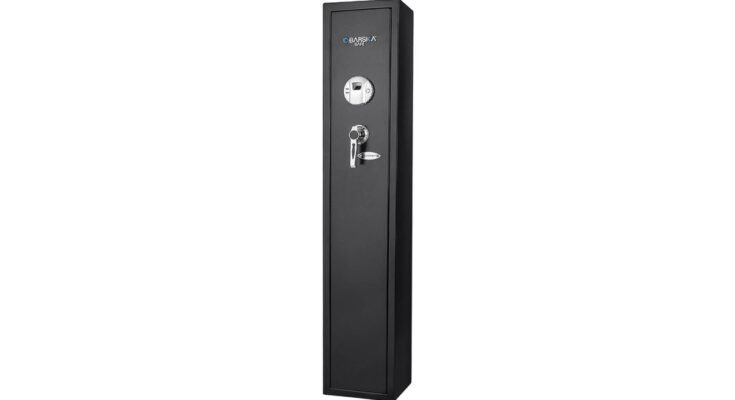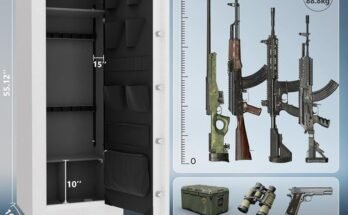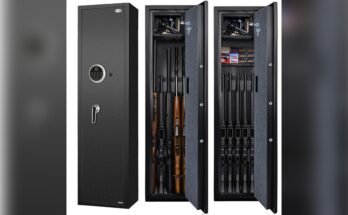When it comes to keeping your rifles safe, you want more than just a basic lock. You need a secure, reliable solution that gives you quick access when it matters most.
That’s where a biometric rifle safe comes in. But with so many options out there, how do you know which features really make a difference? You’ll discover exactly what to look for to protect your firearms effectively, while making sure you can reach them instantly when you need to.
Keep reading to find out how to choose the perfect biometric rifle safe tailored just for you.

Biometric Sensor Accuracy
Biometric sensor accuracy is a key feature in biometric rifle safes. It ensures the safe opens quickly and only for authorized users. A precise sensor reduces the chance of errors and improves security. Understanding sensor accuracy helps you choose a safe that fits your needs.
Fingerprint Recognition Speed
Fast fingerprint recognition saves valuable time in urgent situations. Sensors should unlock the safe within seconds. Slow sensors cause frustration and delay access. Look for safes that process fingerprints in under two seconds. Quick response helps you act swiftly and safely.
False Rejection And Acceptance Rates
False rejection means the sensor denies access to an authorized user. False acceptance means it allows access to an unauthorized person. Both rates must be low for safety and convenience. A good biometric safe has a false rejection rate below 5%. The false acceptance rate should be near zero. This balance protects your rifle while preventing lockouts.
Safe Capacity And Size
Choosing the right size and capacity for a biometric rifle safe is important. It affects how many firearms and accessories you can store safely. The safe should fit your needs today and in the future. Consider the space available in your home too. A safe that is too large or too small can cause problems. Proper sizing means your rifles stay secure and organized.
Number Of Rifles Stored
Think about how many rifles you own now. Also, think about any you may add later. Each rifle needs enough room to avoid damage. Some safes hold just a few rifles. Others store a dozen or more. Choose a safe that fits your collection comfortably. Avoid overcrowding to keep your guns in good shape.
Additional Storage Compartments
Look for safes with extra compartments for ammo and accessories. Small shelves or drawers help organize items. This keeps everything in one place and easy to find. Compartments protect sensitive items from damage. They add value by making your safe more functional. Plan your storage needs beyond just rifles.
Build Quality And Materials
Build quality and materials define the strength and longevity of a biometric rifle safe. A well-built safe protects your firearms from theft, damage, and environmental hazards. It also ensures the safe functions reliably over time. Choosing the right materials and construction is vital for security and peace of mind.
Steel Thickness And Durability
The steel thickness directly affects the safe’s resistance to break-ins. Thicker steel walls make it harder to cut or pry open the safe. Look for safes with at least 10-gauge steel for solid protection. Durable steel maintains its shape and strength under force. Avoid thin or lightweight metals that can bend or break easily.
Fire And Water Resistance
Fire resistance protects firearms from heat damage during a fire. A safe with fireproof insulation can withstand high temperatures for a set time, usually 30 minutes or more. Water resistance prevents damage from floods or water leaks. Sealed doors and waterproof seals keep moisture out. Fire and water resistance extend the life of your firearms and ammunition inside the safe.
Backup Access Options
Backup access options are essential for any biometric rifle safe. They provide a way to open the safe if the biometric system fails. Power issues, sensor errors, or forgotten settings can block access. Backup methods ensure you can still get to your rifles quickly and safely.
Key Override Mechanism
A key override mechanism uses a physical key to open the safe. It works without batteries or electronics. This option is simple and reliable. Keep the key in a safe, secret spot. It is a fail-safe method in emergencies. Not all safes have this feature, so check before buying.
Passcode Entry Features
Passcode entry lets you open the safe with a numeric code. You type the code on a keypad. This method works if the biometric reader does not. Some safes allow multiple passcodes for different users. Choose safes with easy-to-use, responsive keypads. Passcodes offer quick and secure backup access.
Power Source And Battery Life
Power source and battery life are key features in biometric rifle safes. A reliable power source ensures the safe opens quickly. Long battery life means fewer interruptions. Understanding battery details helps avoid lockouts and frustration.
Battery Type And Longevity
Most biometric safes use standard AA or AAA batteries. Some models have rechargeable lithium-ion batteries. Choose a safe with batteries that last long. Battery life can range from six months to two years. Longer battery life means less frequent changes. Always check how easy it is to replace batteries.
Low Battery Alerts
Low battery alerts warn you before power runs out. Alerts come as lights, sounds, or both. These signals give time to replace batteries safely. Without alerts, you risk lockouts at critical moments. Choose safes with clear and early low battery warnings. This feature adds peace of mind and reliability.
Security Features
Security features are the heart of a biometric rifle safe. They protect your firearms from theft and unauthorized access. Strong security builds trust and peace of mind. Choosing the right features helps keep your weapons safe and secure.
Tamper Alerts And Alarms
Tamper alerts warn you if someone tries to break into the safe. Loud alarms scare away intruders and notify you quickly. Some safes send alerts to your phone for instant updates. These features add an extra layer of protection to your safe.
Locking Mechanisms
Locking mechanisms keep the safe firmly shut. Look for models with multiple locking bolts for better security. Some safes use motorized locks that engage automatically. Mechanical backup locks are useful during power or battery failure. A strong lock prevents forced entry and protects your firearms effectively.
Ease Of Installation
Ease of installation is a key factor in choosing a biometric rifle safe. A safe that is simple to set up saves time and stress. It also ensures your rifle is protected quickly and securely. Look for features that make installation straightforward and adaptable to your space.
Mounting Options
Check the mounting options offered by the safe. Some safes come with pre-drilled holes for wall or floor mounting. This helps keep the safe stable and harder to move. Others include brackets or hardware for different mounting styles. More mounting choices mean more places to secure your safe. Make sure the safe fits your preferred mounting spot easily.
Portability
Portability matters if you need to move the safe often. A lightweight safe is easier to carry and relocate. Some models have handles or wheels to help with transport. Portable safes offer flexibility for trips or changes in storage location. Ensure the safe remains strong and secure, even when portable. Balance ease of moving with solid protection for your rifle.
User Capacity And Profiles
User capacity and profiles are key features in a biometric rifle safe. They control who can access the safe and how many people can be registered. This is important for families or groups sharing the safe. It also helps keep the safe secure by limiting access.
Number Of Registered Users
Check how many users the safe can store. Some safes allow only a few fingerprints. Others can store many, up to 20 or more. More user slots mean more people can open the safe. This feature is useful for families or clubs. It ensures everyone authorized can get in quickly.
User Management
Good biometric safes offer easy user management. You should add or remove users without hassle. Some safes let you delete individual fingerprints. Others allow bulk changes for convenience. Look for safes with clear instructions. Managing users should be simple, even for beginners. This keeps control tight and access secure.
Brand Reputation And Warranty
Brand reputation and warranty are key when choosing a biometric rifle safe. A trusted brand often means better quality and service. Warranty gives peace of mind. It shows the company stands behind its product.
Check the brand’s history and customer feedback. A good reputation suggests reliable safes and support. Warranty terms reveal how much the company protects your purchase. Both factors affect your long-term satisfaction.
Customer Reviews
Customer reviews reveal real experiences with the safe. They show if the biometric scanner works well. Look for comments on durability and ease of use. Reviews also highlight any common problems or defects. Pay attention to how the company responds to issues. Good support means the brand cares about buyers.
Warranty Coverage
Warranty coverage should include parts and labor for defects. Longer warranty periods offer more security. Check if the warranty covers the electronic lock and batteries. Some brands offer free repairs or replacements. Understand what voids the warranty, like misuse or unauthorized repairs. A clear, fair warranty reduces future risks.


Frequently Asked Questions
What Makes Biometric Rifle Safes More Secure?
Biometric rifle safes use fingerprint recognition for quick, authorized access. They prevent unauthorized entry with unique biometric data, enhancing security and convenience compared to traditional locks.
How Fast Is The Fingerprint Recognition On These Safes?
Fingerprint recognition typically takes 1-2 seconds. This speed allows for rapid access during emergencies, ensuring you can retrieve your rifle quickly when needed.
Can Biometric Safes Store Multiple Fingerprints?
Yes, most biometric rifle safes can store multiple fingerprints. This feature allows access for trusted family members or authorized users without compromising security.
Are Biometric Rifle Safes Reliable In Power Outages?
Many biometric safes use backup batteries or mechanical override keys. This ensures you can access your safe even during power failures or low battery situations.
Conclusion
Choosing the right biometric rifle safe keeps your firearms secure and easy to access. Look for fast fingerprint recognition and strong build quality. A reliable backup key or code adds extra safety. Size matters—pick one that fits your space and needs.
Prioritize safes with good battery life to avoid surprises. These features protect your guns and give peace of mind. Stay safe, stay prepared.



